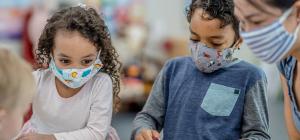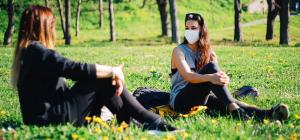
Summer is coming: Wildfire smoke + COVID-19

It is meant as an ominous threat when characters in the popular Game of Thrones series utter “winter is coming”, and I feel the same way about the summer of 2020. The catastrophic wildfire seasons of 2017 and 2018 live vividly in my memory, and the possible intersection between another such catastrophe and the COVID-19 pandemic keeps me awake at night.
I first started studying the health effects of wildfire smoke in British Columbia (BC) in 2003, which was a record-shattering season. More than 265,000 hectares burned that year, 45,000 people were evacuated, 334 homes and businesses were lost, and three first responders died in the line of duty. The Firestorm 2003 provincial review was commissioned in light of the disaster, authored by the Honourable Gary Filmon. This report highlighted the vulnerability of BC forests to extreme wildfire due to accumulation of fuels, mountain pine beetle infestation, and a changing climate. The word “smoke” appears exactly twice in Firestorm 2003 – in both cases as a hindrance to more prescribed burning in the province. The report does not mention the extreme smoke pollution experienced across the southwestern interior for several weeks and its public health impacts, which was the topic of my PhD dissertation.
Wildfire smoke causes episodes of the worst air quality that many people in Canada will ever experience. There is a rapidly-growing literature showing that smoke exposure is associated with a wide range of health outcomes, from sub-clinical markers of systemic inflammation through to premature mortality. Recent national estimates suggest economic impacts well over $1 billion in severe wildfire seasons. Over the past 17 summers BC has experienced five more seasons that exceeded records set in 2003, and multiple months when most of the province was covered in smoke. At this point I would usually start reflecting on the roles of forest management practice and climate change in these alarming trends. Not this year, however -- this year I want to reflect on the intersection between wildfire smoke and COVID-19, and the three things that worry me most:
- First, exposure to air pollution affects immunological function, making it more difficult to fight infections. In a population exposed to wildfire smoke and the novel coronavirus, more people may develop COVID-19 and there may be more severe cases.
- Second, the people most vulnerable to COVID-19 are also the people who are most vulnerable to wildfire smoke. Those with chronic conditions, particularly respiratory disease, the very frail, older adults, and anyone who is insecurely housed.
- Third, our public health infrastructure has limited capacity to think about wildfire smoke right now. Everyone is focused on the clear and immediate threat of COVID-19, and any threat from wildfire smoke seems distant and uncertain in comparison.
As with any other wildfire season, the best thing we can do to protect personal and public health is to prepare for the summer ahead. Reducing exposure is the key to minimizing the health effects of wildfire smoke, and cleaner indoor air is our best defense. Individuals can create cleaner air shelters at home using some simple guidelines and a portable air cleaner. Larger facilities such as nursing homes and acute care centres should consult with heating, ventilation, and air conditioning (HVAC) professionals to develop wildfire smoke plans and to ensure that any necessary supplies are available for the summer months (which may take more time than expected with disruptions to global manufacturing and supply chains).
The most critical part of all these activities is getting started NOW to ensure that systems are ready if and when smoke arrives.There is an important opportunity here for Environmental Health Officers (EHOs) and Licensing Officers to contribute their expertise and to leverage their deep community connections. These roles are critical to the smooth day-to-day operation of public health in Canada, and they can provide a strong foundation for building the on-the-ground awareness and preparedness necessary to make a real difference.
Finally, I want to get back to that question of climate change. There has been unprecedented wildfire activity in BC during two of the past four summers. The driving factors underlying these wildfires are complex and multi-faceted, but climate change has played an important role. We now live in a time when we must anticipate that every summer ahead could bring the next record-shattering wildfire season. We can hope for better, but we should prepare for the worst. Let’s keep our fingers crossed for 2020 and get to work.
About the Author
Dr. Sarah Henderson is the Senior Environmental Health Scientist at the BC Centre for Disease Control. She leads a program of applied research and surveillance to support good environmental health policy for the province. Her expertise covers a wide range of content areas, and she is an internationally recognized expert on wildfire smoke exposure and its public health impacts.







